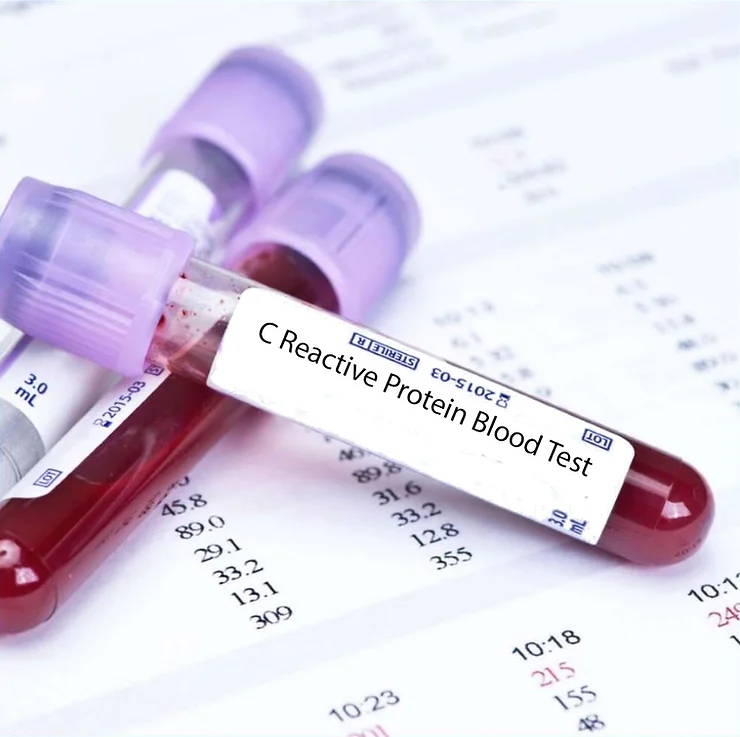Let’s look at seven blood markers of inflammation and then consider some valuable intestinal markers of inflammation that you can have tested by your doctor.
Seven blood tests for inflammation
I previously wrote to you about these blood markers of inflammation:
C-reactive protein (CRP), plasma viscosity,[1] serum ferritin,[2] erythrocyte sedimentation rate (ESR), hemoglobin A1c (HbA1c), and fasting Insulin.
Although there are more than 78 inflammation-related biomarkers,[3] here are seven additional important blood tests that indicate systemic consequences of inflammation and clinical disease activity. Consider discussing them with your doctor.
White blood cell (WBC) count
The CBC (complete blood cell) test measures the white blood cells (WBCs), also called leukocytes and several other parameters of your blood cells. Leukocytes (WBCs) increase in your blood in response to infection or inflammation such as trauma. Extremely elevated WBCs indicate a form of leukemia.
There are several types of white blood cells that give us clues to underlying illness:
Neutrophils rise with bacterial infections of any kind, and recent trauma
Lymphocytes rise in viral infections typically of acute nature (influenza, etc.)
Basophils elevate in allergic/hypersensitivity conditions, parasites, or leukemia
Monocytes rise in chronic infections, viral infections (mumps, measles, Epstein-Barr Virus, and other viruses), autoimmune diseases, cancers, tuberculosis, and more.
Eosinophils rise with chronic allergies or parasite infection.
Thyroid peroxidase (TPO) antibodies
TPO antibodies are found when the immune system mistakenly attacks the thyroid. This starts when T lymphocytes (white blood cells) invade thyroid gland tissue. This causes a silent and painless inflammation that triggers TPO antibodies to form which then block important thyroid-specific proteins such as thyroid peroxidase. This gradually destroys the thyroid tissue.
Interleukin 1 (IL-1)
Interleukins are “pro-inflammatory” cell-signaling protein molecules in our body associated with acute and chronic inflammation.[4] There are 11 members of the Interleukin 1 family. In particular, IL-1β has become a therapeutic target (they make drugs against it) for auto-immune inflammatory diseases. Apparently, neutralizing IL-1β causes a rapid and sustained lowering of disease severity and works differently than immunosuppressive drugs.
Interleukin 6 (IL-6)
Interleukin 6 (IL-6) is produced naturally in your body in response to infections, tissue injuries, and the need for more red blood cell production.[5] There are many functions for IL-6, but to name a few, it affects the delicate balance of your hypothalamus, pituitary, and adrenal glands (“HPA axis”) and is associated with central obesity, high blood pressure, and insulin resistance (of type-2 diabetes). It is a involved in the inflammation behind coronary heart disease.[6] Elevated IL-6 correspond with relapse of Crohn’s disease.[7]
Tumor necrosis factor alpha (TNF- α)
Tumor necrosis factor (a.k.a. cachexin or cachectin) is a cytokine found in systemic inflammation of Alzheimer’s disease, cancer, psoriasis, inflammatory bowel disease and depression.[8] Infliximab (Remicade) is a drug that treats some of these autoimmune conditions by its action against TNF- α.
Red blood cell distribution width (RDW)
RDW is a strong predictor of mortality in the general population. Higher RDW values are strongly associated with increased risk of death compared to the lowest quintile of RDW measurements in adults aged 45 and older.[9]
Serum amyloid A
Serum amyloid A increases in response to tissue injury and inflammation in the body. In patients with rheumatoid arthritis, elevation of this biomarker is associated with both joint inflammation and the risk of heart disease and kidney disease. When persistently elevated, serum amyloid A increases deposition of amyloid proteins in different tissues and organs (a.k.a. amyloidosis).
Two markers of intestinal inflammation
There are two markers of stool your doctor can order, which indicate intestinal inflammation.
Fecal Calprotectin
Fecal calprotectin is a protein measurable in stool. Elevated calprotectin indicates neutrophil (WBC involved with bacterial infections) migration to the intestinal lining. This occurs with inflammatory bowel disease. The higher the level of fecal calprotectin, the more intestinal inflammation you have. Consider the many chronic disease states significantly related to ongoing intestinal hyper-permeability condition known as Leaky Gut.[10]
Fecal Lactoferrin
Lactoferrin can be used to help determine the level of inflammation in your intestines.
The lactoferrin protein is released by neutrophils (WBC involved with bacterial infections) when digestive tract inflammation is present. This is measured in your stool.
Although all these tests do not point to any specific disease condition, they could guide you with the effectiveness of your anti-inflammatory diet and anti-inflammatory lifestyle.
To long-term health and feeling good,
Michael Cutler, M.D.
[1] Bradlow BA, Haggan JM. A comparison of the plasma viscosity and the erythrocyte sedimentation rate as screening tests. S Afr Med J. 1979 Mar 17;55(11):415-20. PubMed PMID: 432746. https://www.ncbi.nlm.nih.gov/pubmed/432746
[2] Kell DB, Pretorius E. Serum ferritin is an important inflammatory disease marker, as it is mainly a leakage product from damaged cells. Metallomics. 2014 Apr;6(4):748-73. PubMed PMID: 24549403. https://www.ncbi.nlm.nih.gov/pubmed/24549403
[3] Kitahara CM, Trabert B, Katki HA, Chaturvedi AK, Kemp TJ, Pinto LA, Moore SC, Purdue MP, Wentzensen N, Hildesheim A, Shiels MS. Body mass index, physical activity, and serum markers of inflammation, immunity, and insulin resistance. Cancer Epidemiol Biomarkers Prev. 2014 Dec;23(12):2840-9. https://www.ncbi.nlm.nih.gov/pubmed/25249326. PubMed PMID: 25249326
[4] Dinarello CA. Interleukin-1 in the pathogenesis and treatment of inflammatory diseases. Blood. 2011 Apr 7;117(14):3720-32. Review. PubMed PMID: 21304099. https://www.ncbi.nlm.nih.gov/pubmed/21304099
[5] https://www.ncbi.nlm.nih.gov/pmc/articles/PMC4176007/
[6] Yudkin JS, Kumari M, Humphries SE, Mohamed-Ali V. Inflammation, obesity, stress and coronary heart disease: is interleukin-6 the link? Atherosclerosis. 2000 Feb;148(2):209-14. Review. PubMed PMID: 10657556. https://www.ncbi.nlm.nih.gov/pubmed/10657556
[7] Louis, E, Belaiche, J, van Kemseke, C, Franchimont, D, de Groote, D, Gueenen, V, and Mary, JY. A high serum concentration of interleukin-6 is predictive of relapse in quiescent Crohn's disease. Eur J Gastroenterol Hepatol. 1997; 9: 939–944.
[8] https://en.wikipedia.org/wiki/Infliximab
[9] Patel KV, Ferrucci L, Ershler WB, Longo DL, Guralnik JM. Red blood cell distribution width and the risk of death in middle-aged and older adults. Arch Intern Med. 2009 Mar 9;169(5):515-23. PubMed
PMID: 19273783. https://www.ncbi.nlm.nih.gov/pubmed/19273783
[10] Fasano A. Leaky gut and autoimmune diseases. Clin Rev Allergy Immunol. 2012 Feb;42(1):71-8. Review. PubMed PMID: 22109896. https://www.ncbi.nlm.nih.gov/pubmed/22109896









